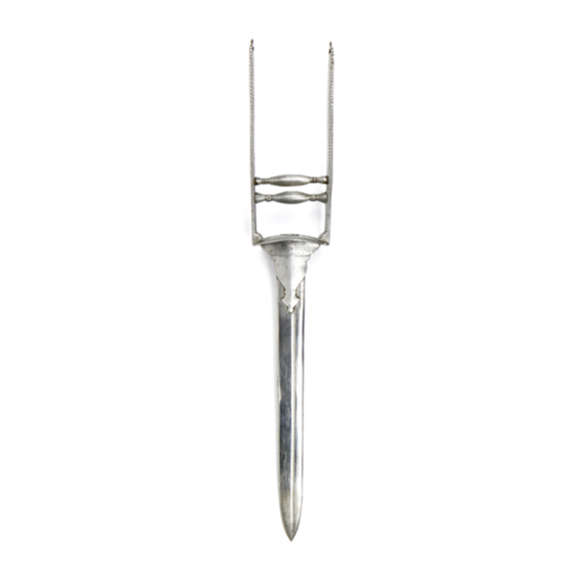Language: Persian
Source: Classical literature
Description
Chahār kham means "four curved". It is the name of a type of bow given in Kitāb Hidāyat al-rāmī ("The Archer's Guide") by Muḥammad Budah'ī, written around 1500 AD.1
 A fine chahār-kham bow.
A fine chahār-kham bow.
Sold by Mandarin Mansion in 2019.
Chahār-kham are composite bows made with wooden cores, horn bellies, and sinew covered backs. They are typically covered completely with (painted) birch bark. The shape is quite extreme, with its deeply setback handle the bow represents a somewhat archaic form of composite bow that reminds a of ancient Scythian bows. Often, there are one to three rows of sinew on the back of the bow.
Chahār kham bows were probably once in widespread use among much of the Indian subcontinent, but production continued the longest in Sindh, where in the early 1900's at least one bowyer was apparently still active.2 Because of this, the bow is now often referred to as "Sindh bow".
Peculiar bird hunting technique
Major J. B. Farley describes a peculiar bird hunting technique used by the Sindh archers:
The technique of the Sinds was to hold the bow in a horizontal position near the ground and place the arrow on the string at angle; that is, with the nock several inches above the normal nocking point, so that the arrow received a side thrust as well as forward thrust and, consequently, whirled around like a pinwheel while it went forward only a few yards. The idea seemed to be knock the bird down without shedding its blood. Major Farley commented on the great waste of force in using such strong bows to shoot in a manner that would carry such a little distance and feebly. We have never seen any other arrows like these in museum or elsewhere and believe that they are quite rare specimens in this country, if not unique. 3
-Robert Potter Elmer, 1945
Also see
Article: Measurements of a chahār kham bow.
Notes
1. See: Edward McEwen; The chahār-kham or "four curved" bow of India. Published in Elgood (editor); Islamic Arms and Armour, London Scolar Press 1979. Footnote 1. The consulted manuscript Kitāb Hidāyat al-rāmī was purchased by the British Library in 1983 where it remains until this day under accession number: BLL01005345409. The work was dedicated to Husayn Shāh, ruler of Bengal from 1493-1519 A.D.
2. Cf. Nabih Amin Faris & Robert Potter Elmer; Arab Archery. Princeton. 1945. Elmer was presented a "magnificent modern composite bow" by Major J. B. Farley who had purchased it in Sind.
3. Ibid. Appendix 17: Featherless arrows.






